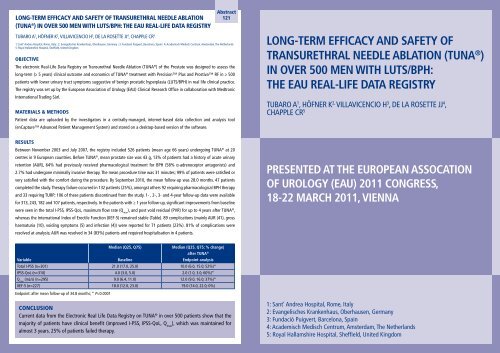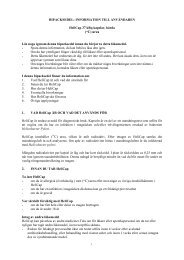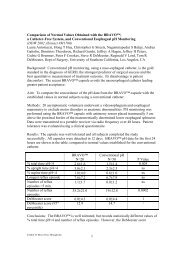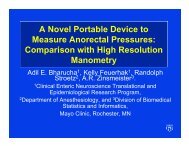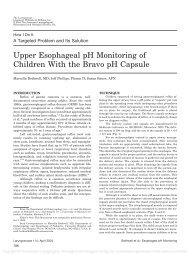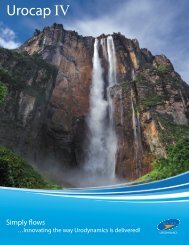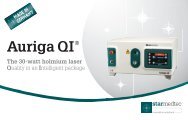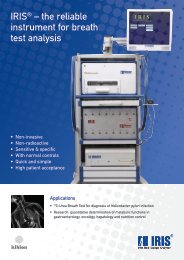long-term efficacy and safety of transurethral needle ablation (tuna®)
long-term efficacy and safety of transurethral needle ablation (tuna®)
long-term efficacy and safety of transurethral needle ablation (tuna®)
You also want an ePaper? Increase the reach of your titles
YUMPU automatically turns print PDFs into web optimized ePapers that Google loves.
LONG-TERM EFFICACY AND SAFETY OF TRANSURETHRAL NEEDLE ABLATION<br />
(TUNA ® ) IN OVER 500 MEN WITH LUTS/BPH: THE EAU REAL-LIFE DATA REGISTRY<br />
TUBARO A 1 , HÖFNER K 2 , VILLAVICENCIO H 3 , DE LA ROSETTE JJ 4 , CHAPPLE CR 5<br />
1: Sant’ Andrea Hospital, Rome, Italy | 2: Evangelisches Krankenhaus, Oberhausen, Germany | 3: Fundació Puigvert, Barcelona, Spain | 4: Academisch Medisch Centrum, Amsterdam, The Netherl<strong>and</strong>s<br />
5: Royal Hallamshire Hospital, Sheffield, United Kingdom<br />
OBJECTIVE<br />
The electronic Real-Life Data Registry on Transurethral Needle Ablation (TUNA ® ) <strong>of</strong> the Prostate was designed to assess the<br />
<strong>long</strong>-<strong>term</strong> (≥ 5 years) clinical outcome <strong>and</strong> economics <strong>of</strong> TUNA ® treatment with Precision Plus <strong>and</strong> Prostiva RF in ≥ 500<br />
patients with lower urinary tract symptoms suggestive <strong>of</strong> benign prostatic hyperplasia (LUTS/BPH) in real life clinical practice.<br />
The registry was set up by the European Association <strong>of</strong> Urology (EAU) Clinical Research Office in collaboration with Medtronic<br />
International Trading Sàrl.<br />
MATERIALS & METHODS<br />
Patient data are uploaded by the investigators in a centrally-managed, internet-based data collection <strong>and</strong> analysis tool<br />
(enCapture Advanced Patient Management System) <strong>and</strong> stored on a desktop-based version <strong>of</strong> the s<strong>of</strong>tware.<br />
RESULTS<br />
Between November 2003 <strong>and</strong> July 2007, the registry included 526 patients (mean age 66 years) undergoing TUNA ® at 20<br />
centres in 9 European countries. Before TUNA ® , mean prostate size was 43 g, 13% <strong>of</strong> patients had a history <strong>of</strong> acute urinary<br />
retention (AUR), 64% had previously received pharmacological treatment for BPH (58% α-adrenoceptor antagonists) <strong>and</strong><br />
2.7% had undergone minimally invasive therapy. The mean procedure time was 31 minutes; 99% <strong>of</strong> patients were satisfied or<br />
very satisfied with the comfort during the procedure. By September 2010, the mean follow-up was 28.0 months. 47 patients<br />
completed the study. Therapy failure occurred in 132 patients (25%), amongst others 92 requiring pharmacological BPH therapy<br />
<strong>and</strong> 33 requiring TURP; 106 <strong>of</strong> these patients discontinued from the study. 1- , 2-, 3- <strong>and</strong> 4-year follow-up data were available<br />
for 313, 243, 182 <strong>and</strong> 107 patients, respectively. In the patients with ≥ 1 year follow-up, significant improvements from baseline<br />
were seen in the total I-PSS, IPSS-QoL, maximum flow rate (Q max<br />
), <strong>and</strong> post void residual (PVR) for up to 4 years after TUNA ® ,<br />
whereas the International Index <strong>of</strong> Erectile Function (IIEF-5) remained stable (Table). 89 complications (mainly AUR (41), gross<br />
haematuria (10), voiding symptoms (5) <strong>and</strong> infection (4)) were reported for 71 patients (23%). 81% <strong>of</strong> complications were<br />
resolved at analysis; AUR was resolved in 34 (83%) patients <strong>and</strong> required hospitalisation in 4 patients.<br />
Abstract<br />
121<br />
LONG-TERM EFFICACY AND SAFETY OF<br />
TRANSURETHRAL NEEDLE ABLATION (TUNA ® )<br />
IN OVER 500 MEN WITH LUTS/BPH:<br />
THE EAU REAL-LIFE DATA REGISTRY<br />
TUBARO A 1 , HÖFNER K 2, VILLAVICENCIO H 3 , DE LA ROSETTE JJ 4 ,<br />
CHAPPLE CR 5<br />
PRESENTED AT THE EUROPEAN ASSOCATION<br />
OF UROLOGY (EAU) 2011 CONGRESS,<br />
18-22 MARCH 2011, VIENNA<br />
Median (Q25, Q75)<br />
Median (Q25, Q75; % change)<br />
Variable<br />
Baseline<br />
after TUNA ®<br />
Endpoint analysis<br />
Total I-PSS (n=301) 21.0 (17.0, 25.0) 10.0 (6.0, 15.0; 52%)*<br />
IPSS-QoL (n=310) 4.0 (3.0, 5.0) 2.0 (1.0, 3.0; 60%)*<br />
Q max<br />
(mL/s) (n=295) 9.0 (6.4, 11.0) 12.0 (9.0, 16.0; 37%)*<br />
IIEF-5 (n=227) 18.0 (12.0, 23.0) 19.0 (14.0, 22.0; 0%)<br />
Endpoint: after mean follow-up <strong>of</strong> 34.8 months; * P
LONG-TERM EFFICACY AND SAFETY OF TRANSURETHRAL NEEDLE ABLATION (TUNA ® )<br />
IN OVER 500 MEN WITH LUTS/BPH: THE EAU REAL-LIFE DATA REGISTRY<br />
A. TUBARO 1 , K. HÖFNER 2 , H. VILLAVICENCIO 3 , J.J. DE LA ROSETTE 4 , C.R. CHAPPLE 5 1: Sant’ Andrea Hospital, Rome, Italy<br />
2: Evangelisches Krankenhaus, Oberhausen, Germany<br />
3: Fundació Puigvert, Barcelona, Spain<br />
4: Academisch Medisch Centrum, Amsterdam, The Netherl<strong>and</strong>s<br />
5: Royal Hallamshire Hospital, Sheffield, United Kingdom<br />
INTRODUCTION<br />
• Electronic Real-Life Data Registry on TransUrethral Needle Ablation (TUNA ® )<br />
Therapy with Precision TM Plus <strong>and</strong> Prostiva TM RF in the treatment <strong>of</strong> lower<br />
urinary tract symptoms suggestive <strong>of</strong> benign prostatic hyperplasia (LUTS/BPH)<br />
• Patient enrolment started in November 2003<br />
• Collaboration between the EAU Clinical Research Office (EAU-CRO) <strong>and</strong><br />
Medtronic International Trading Sàrl<br />
• Aims: to document information on the <strong>long</strong>-<strong>term</strong> (≥ 5 years) use <strong>of</strong> TUNA ®<br />
Therapy in ≥ 500 patients with LUTS/BPH managed in real-life clinical practice<br />
• Primary objective: evaluate re-treatment rate<br />
• Secondary objectives:<br />
- analyse subjective <strong>and</strong> objective improvement<br />
- obtain health economics data<br />
MATERIALS & METHODS<br />
• enCapture Advanced Patient Management System<br />
• data collection <strong>and</strong> analysis tool that enables the investigators to<br />
electronically maintain their patient records (Figure 1) <strong>and</strong> upload these in<br />
the centrally-managed, internet-based database<br />
Figure 1: The electronic Advanced Patient Management System (enCapture) - screenshot<br />
• Patient enrolment was completed in July 2007<br />
• Outcomes are evaluated at 6 months, <strong>and</strong> will further be collected at<br />
12 months <strong>and</strong> then yearly for up to 5 years<br />
RESULTS<br />
1. Patient population<br />
• An interim analysis was performed in September 2010<br />
• on all enrolled patients (N=526; mean follow-up [FU] <strong>of</strong> 28.0 months)<br />
(Figure 2)<br />
• on patients with FU data <strong>of</strong> at least 1 year (N=313; mean FU <strong>of</strong> 34.8<br />
months)<br />
- 2-year FU was available for 243 patients<br />
- 3-year FU was available for 182 patients<br />
- 4-year FU was available for 107 patients<br />
• The baseline characteristics <strong>of</strong> the 12-month FU (12m-FU) group did not differ<br />
from the total group (Table 1)<br />
Lauchhammer, Germany<br />
Vicenza, Italy<br />
London, UK<br />
Wilhelmshaven, Germany<br />
Uddevalla, Sweden<br />
Geneva, Switzerl<strong>and</strong><br />
Neustadt, Germany<br />
R<strong>and</strong>ers, Denmark<br />
Casale, Italy<br />
Egersund, Norway<br />
Barcelona, Spain<br />
Como, Italy<br />
Stockholm, Sweden<br />
Heidelberg, Germany<br />
Vilvoorde, Belgium<br />
Leverkusen, Germany<br />
Dresden, Germany<br />
Oberhausen, Germany<br />
Cologne, Germany<br />
Kiel, Germany<br />
19<br />
17<br />
17<br />
16<br />
14<br />
13<br />
12<br />
10<br />
9<br />
8<br />
5<br />
4<br />
1<br />
1<br />
Figure 2: Number <strong>of</strong> patients in analysis per centre<br />
Table 1: Baseline parameters<br />
28<br />
44<br />
40<br />
All patients<br />
79<br />
73<br />
116<br />
12m-FU patient group<br />
Number <strong>of</strong> patients in analysis N=526 N=313<br />
Age (years) ± SD (min-max) 66 ± 9 (35-91) 66 ± 8 (35-88)<br />
Prostate size (g) ± SD (min-max) 43 ± 20 (12-199) 43 ± 18 (13-199)<br />
Indication for TUNA ®<br />
• LUTS/BPH<br />
• Other: chronic prostatitis<br />
94%<br />
6%<br />
93%<br />
7%<br />
Co-morbidities 51% 51%<br />
Urinary retention (UR):<br />
• at the time <strong>of</strong> screening<br />
• ever had UR (total)<br />
10%<br />
13%<br />
6%<br />
9%<br />
2. Procedural data<br />
• Local anaesthesia (lidocaine liquid/gel) was most commonly used (in 23% /<br />
34% <strong>of</strong> patients). Prostatic block (7%), <strong>and</strong> general (18%) <strong>and</strong> spinal (24%)<br />
anaesthesia were also used. In 27% <strong>of</strong> the cases another anaesthetic was<br />
used. Multiple anaesthetics were possible; therefore, the sum does not<br />
correspond to 100%<br />
• The procedure lasted on average 31 min (± 14 min) to perform 7 (± 2) lesions<br />
in the right (3), left (3) <strong>and</strong> median (1) lobes <strong>of</strong> the prostate<br />
3. Pain during <strong>and</strong> satisfaction with procedure (Figure 3)<br />
• The majority <strong>of</strong> patients reported no pain or scored a pain level ≤ 5<br />
• 99% <strong>of</strong> the patients were satisfied or very satisfied with the procedure<br />
% <strong>of</strong> patients<br />
35<br />
30<br />
25<br />
20<br />
15<br />
10<br />
5<br />
0<br />
No<br />
Pain<br />
N=428<br />
Unsatisfactory<br />
Satisfactory<br />
Very satisfactory<br />
N=427<br />
47.0%<br />
5<br />
0.9%<br />
52.1%<br />
Worst<br />
Pain<br />
4. Clinical outcome variables<br />
(in 12m-FU group at endpoint, i.e. after mean FU <strong>of</strong> 38.8 months)<br />
Symptoms<br />
• Compared to baseline, there was a median improvement <strong>of</strong> 52%<br />
(P < 0.0001) in total International Prostate Symptom Score (I-PSS) at<br />
endpoint (Table 2)<br />
• The improvement in total I-PSS was maintained over time (Figure 4)<br />
• The percentage <strong>of</strong> patients with mild symptoms (total I-PSS 0-7) increased<br />
from 1% at baseline to 35% at endpoint<br />
• The percentage <strong>of</strong> patients with severe symptoms (total I-PSS 20-35)<br />
decreased from 60% at baseline to 11% at endpoint<br />
Table 2: Clinical outcome variables at baseline <strong>and</strong> endpoint. 12m-FU group<br />
Median<br />
(Q25, Q75)<br />
Median<br />
(Q25, Q75; % change)<br />
Variable<br />
Baseline<br />
after TUNA ®<br />
Endpoint analysis<br />
Total I-PSS (n=301) 21.0 (17.0, 25.0) 10.0 (6.0, 15.0; 52%)*<br />
IPSS-QoL (n=310) 4.0 (3.0, 5.0) 2.0 (1.0, 3.0; 60%)*<br />
Q max<br />
(mL/s) (n=295) 9.0 (6.4, 11.0) 12.0 (9.0, 16.0; 37%)*<br />
IIEF-5 (n=227) 18.0 (12.0, 23.0) 19.0 (14.0, 22.0; 0%)<br />
Endpoint: after mean follow-up <strong>of</strong> 34.8 months; * P


